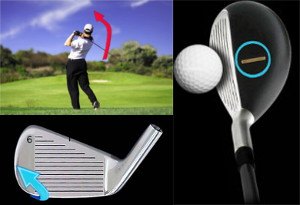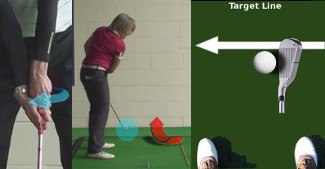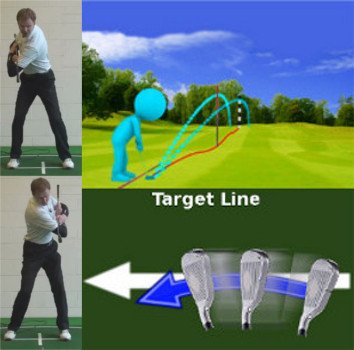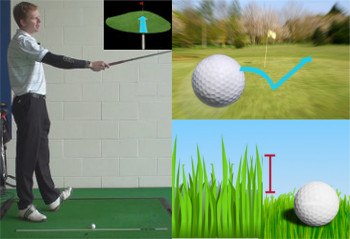Hitting a hook can be extremely frustrating, but it doesn't have to be a life sentence. You can absolutely get rid of the hook pattern in your game, as long as you are willing to put in some work on the range to alter your technique appropriately. By taking the hook-causing elements out of your swing as quickly as possible, you should be able to get on track in the relatively near future. Be patient with the process, don't be too hard on yourself, and enjoy playing the game with a reliable and hook-free ball flight!

There are a variety of shot shapes possible in the game of golf, and the one you are left with on any given shot depends on how the club is delivered to the back of the ball (in addition to some other factors). One shot shape which is usually unwanted is the hook, and we are going to discuss this type of shot in great detail in this article. If you are struggling with a hook currently, the content below may help you work your way out of that pattern.
Most of the time, you don’t want to hit a hook. There may be a rare occasion when you need to turn the ball hard around a corner and you actually want to hit a hook as a result, but those situations will be few and far between. It’s one thing to hit a consistent draw where the ball just turns gently to the side as it flies – but it is another thing entirely to hit an out-of-control hook. For players who like to draw the ball, making sure that draw doesn’t turn into a hook is a key component of their development.
All of the content below is based on a right-handed golfer. If you happen to play left-handed, please take a moment to reverse the directions as necessary.
— What is a Hook and Why Does It Happen?
For a right-handed golfer, a hook is a shot which spins wildly from right to left as it flies. This mistake is usually seen with longer clubs, although it’s possible to hook a short club if your mechanics are badly out of position. While playing a right-to-left shot pattern is certainly a great way to play the game when it is under control, that’s not what we are talking about here. Most golfers would call a controlled shot that turns to the left a ‘draw’, where the term ‘hook’ would be used when the ball is turning aggressively to the left and missing the target badly.
Most of the time, you don’t even need to look up to watch the ball fly when you hit a hook. You can feel that things have gone wrong when you strike the ball, and you already know the shot is going to turn left even before you find the ball with your eyes. It’s a bad feeling to know that you have hit a hook, since these kinds of shots swing so wildly out of control and finish just about anywhere when they finally stop rolling. Some golfers who struggle with this issue regularly can even feel the hook coming on before they make contact. To be sure, that’s a place you don’t want to find yourself with your game.
As is the case with solving any problem, you need to fully understand what it is that makes the ball curve to the left before you can actually make the right corrections. Let’s take a closer look at the basics of what causes the ball to curve so suddenly to the left.
| GOLF FIXES BY PGA PROS |
|---|
| Snap Hook – 3 Good Cures To Fixes It | Video | Article |
| How To: Fix Your Hook | Video | Article |
| Relaxing The Hands To Fix A Golf Hook Shot | Video | Article |
| What Happens When Hitting A Golf Hook Shot | Video | Article |
| Pull Hook, Causes and Cures Golf | Video | Article |
| Snap Hook Golf, 3 Good Cures To Fixes It | Video | Article |
| Fix How To: Fix Your Hook | Video | Article |
| Dealing With The Golf Pull Hook Part Three | Video | Article |
| Best 3 Ways To Cure Hook Shots – Women's Golf Tip | Video | Article |
| Fix Your Hook Golf Lesson | Video | Article |
| Golf Swing Tip: Open Clubface to Hit Intentional Hook | Video | Article |
| Help Correct – Cure a Golf Hook | Video | Article |
| How To Live With A Hook Golf Shot | Video | Article |
| An Anti-Hook Practice Drill | Video | Article |
| Hook Lesson by PGA Pro Tom Stickney | Video | Article |
| The Top Ways to Fix Your Hook | Video | Article |
| Three Common Hook Causes | Video | Article |
| Driver Snap Hook Swing Fault by Tom Stickney | Video | Article |
| LESSONS |
|---|
| Pro Golf Shot Bubba Watson: Monster Hook | Video | Article |
| Hook Lesson by PGA Teaching Pro Adrian Fryer | Video | Article |
| YOUR GRIP |
|---|
| Check Your Golf Grip When Hitting A Hook Shot | Video | Article |
| Can Your Golf Grip Cause A Hook | Video | Article |
| Check Your Golf Grip When Hitting A Hook Shot | Video | Article |
| Does Your Grip Cause Your Hook | Video | Article |
| PRACTICE DRILLS |
|---|
| An Anti-Hook Practice Drill | Video | Article |
| Hook Golf Shot Drills Introduction | Video | Article |
| Key Points To Address With The Golf Set Up In Low Hook Shots | Video | Article |
| Hook Golf Shot Drill 2: Basket behind ball inside line | Video | Article |
| Hook Golf Shot Drill 3: Hold off finish badge to sky | Video | Article |
| Hook Golf Shot Drill 4: Walk through drill | Video | Article |
| The Cause Of A Low Hook Shot With The Golf Irons | Video | Article |
| What Is A Low Hook Shot With The Golf Irons | Video | Article |
| Slice Golf Shot Drill 8 Hook chips for rotation | Video | Article |
| Golf Backswing Issues With The Low Hook Shot | Video | Article |
| Equipment Considerations When Golfers Hit The Low Hook Shot | Video | Article |
| GOLF QUESTIONS |
|---|
| What Causes a Golf Pull Hook Shot? | Video | Article |
| How Can I Intentionally Hook My Golf Ball? | Video | Article |
| Whats the best fix for a hook? | Video | Article |
| GOLF EXERCISES |
|---|
| More Body Rotation To Help Fix The Golf Hook Shot | Video | Article |

- Spinning to the left. To an experienced golfer, this first point is going to be pretty obvious. However, it’s worth pointing out, as newer players might not understand that it is the spin you place on the ball that is responsible for determining how it is going to fly through the air. When you hit a hook as a right-handed player, you are producing a shot that is spinning hard to the left. Hooks are more likely with long clubs because your long shots won’t have as much backspin as shorter shots, so they can have a higher rate of sidespin and turn more aggressively as a result.
- Club closed relative to the swing path. This is where many golfers start to get confused, so take your time reading through this point to make sure you understand it clearly. When you swing the club through the hitting area, the path that your clubhead takes through the ball is known as the ‘swing path’. At the moment of impact, your club face will be pointed in a specific direction (hopefully somewhere near the target). It is a comparison between your swing path and your club face position that will tell you what kind of spin is going to be imparted on the ball. If your face position is roughly square to the swing path, you’ll hit a pretty straight shot. However, if the face is closed relative to the swing path, the ball is going to curve left. If it’s closed just slightly, you will hit a controlled draw. But if the face is closed rather dramatically, that draw will turn into a hook. Some players seem to think that swinging on an inside-out path is automatically going to create a hook, but that just isn’t the case. You’ll only hit a hook if the face is closed relative to your swing path at the moment of impact. Getting away from the hook and getting your ball flight back on track is going to require gaining control over both the path of your swing and the position of your club face.
- Poor contact quality. The previous point highlights the key relationship between the swing path and face angle that you need to understand if you are going to understand the basic cause of the hook. With that said, you can make things worse by making poor contact with the ball at impact. Specifically, if you hit the ball out toward the toe of the club, you will likely come away with even more spin to the left, and an even nastier hook. It’s always a good idea to strike the ball in the middle of the face – or as close to the middle as possible – so it should be no surprise that missing the sweet spot can lead to hook problems.
The main takeaway from this section is that placing right-to-left spin on the golf ball is going to cause it to turn to the left. A little sidespin will result in a controlled draw – which is a very useful shot – while a lot of spin will lead to a hook that is likely to get you in trouble. Although you can’t really see the spin on the golf ball as it flies through the air, it’s important to understand that this game is all about controlling spin. If you can manage the spin you put on the ball successfully, you should be able to hit your targets without much trouble.
— The Common Causes
Now that we have laid out a basic explanation of why the ball hooks to the left on some of your shots, we need to talk about what is going on in your swing to lead to that result. Of course, without seeing you swing the club, we can’t say with any degree of certainty why you are hitting hooks. However, there are a few common issues that seem to plague many golfers, and we will outline those below. As you read, think about your own swing to see if you can determine which of these issues seems to be giving you trouble.

- An extremely strong grip. The grip is one of the basic fundamentals in the game of golf, yet it is overlooked by many players. Specifically, golfers who got started in the game on their own without any guidance may have grip problems. If you use an extremely strong grip, you may be more prone to hit a hook than someone with a weaker grip. That doesn’t mean you’ll automatically hit a hook with a strong grip – plenty of players use this kind of grip successfully – but it is a risk to consider. A strong grip is one where your hands are turned significantly to the right on the handle as you are looking down from above. For instance, if you can see all of the knuckles on the back of your left hand when you form your grip, your hands are in a strong position. Since a strong grip typically leads to active hands through the hitting area, you might find that you ‘flip’ the clubface closed at impact and hit a hook more often than you would like. So, how do golfers who use a strong grip manage to avoid a hook? Typically, they do it with excellent body rotation through impact. If you turn your body hard to the left throughout the downswing, you can keep the clubface in a square position and avoid it turning over prematurely. If you are going to stick with a strong grip, be sure to focus on body rotation to keep the club in the right position and stay away from the dreaded hook.
- Poor lower body action. We just mentioned how body rotation helps golfers stay away from hooks, and that is actually true for every player – not just those with a strong grip. If you turn your body nicely through the hitting area, it will be hard to hit a hook. From the top of the swing, make sure your lower body rotates aggressively on the way down and all the way through impact. Not only is this move good for staying away from a hook, but it can also help you build significant speed in the downswing. Some amateur golfers struggle to get their lower body started at the top of the downswing, instead waiting too long for the legs to get in on the action. If you make that mistake, the club will get down to the ball long before your hip rotation can clear the way, and you might shut the face down as a result. Even if you do have good mechanics in this part of the swing on the range, you might struggle to rotate fully when you get nervous on the course. Making a good rotational move requires total commitment to the shot at hand. If you have any doubts about where the shot is going to go, you might give up on the turn and wind up hitting a hook. Do your best to commit fully to each shot and believe that you are going to wind up with a good result.
- Improper stance. Even if you have good technique in the moving parts of your swing, you might struggle to hit good shots simply because your stance is flawed. At address, you should be standing with your feet roughly parallel to the intended target line for the shot. There is a little wiggle room there, as some players like to be a bit open or closed, but you shouldn’t stray too far from square. If you are in an extremely closed position at address, you’ll likely swing out at the ball from the inside, and you might produce a nasty hook as a result. To make sure your stance isn’t a problem, spend some time rehearsing your address position in front of a mirror to make sure everything is as square as possible.
There are plenty of ways to wind up hitting a hook, but the three points listed above are a good starting point as you work on finding the root cause of your hook issues. If you can’t seem to figure out what is going wrong in your swing, try recording a few swings on video so you can slow things down and see for yourself what is happening.
— Two Anti-Hook Drills
As a golfer, it is always helpful to have a least a few drills in mind when you head to the range. The best thing to do is have drills in mind that are going to specifically address the problems that you face in your game. Even hitting just a few balls while using an appropriate drill can go a long way toward helping you make progress. Let’s take a look at two drills that may be able to help you move away from your hook pattern.

- No-club rotations. This first drill doesn’t even require the use of a club, and you can perform this move anywhere you have free space and a few minutes available. Without a club, take your stance as if you were going to hit a shot. Instead of putting your hands down in front of you as you would when actually playing golf, just place your hands across your chest, which each hand touching the opposite shoulder. For the ‘backswing’, you are going to turn your shoulders fully away from the imaginary target. Then, to start the ‘downswing’, turn your hips toward that imaginary target and let the rest of your body follow. As you perform the drill, always be careful to control your balance as successfully as possible. This drill helps you learn how to turn your hips through toward the target because you don’t have the distraction of the club or a ball to worry about. You can focus on the timing of your rotation, with the upper body managing the backswing and the lower body managing the downswing. While you can do this drill at home, it’s also good to do at the driving range before you hit your shots. Make a few practice rotations as described above without the use of a club, then pick up a club and get started with your regular practice session.
- Start it left. In this drill, you will be hitting shots, so you will need a club (a mid-iron is good) along with some range balls. This drill starts by picking a very specific target that you will use to provide an aim point for each shot. It doesn’t really matter how far off in the distance the target may be, as you aren’t trying to get the ball close – you are just using that target as a point of reference. Once you’ve selected a target, take your address position and settle in to make a swing. The goal here is to start the ball to the left of that selected target line. To do so, you’ll need to swing down the line or just slightly across the ball from outside-in. This is the opposite swing pattern that would generally be associated with a hook, so it might be hard to succeed at this drill initially. That’s okay – stick with it and keep hitting shots until you find a way to start the ball to the left. Don’t worry if the shots aren’t all that pretty at first. As long as you are starting it to the left, you should be improving your swing path. After a few successful shots, go back to simply trying to hit targets and use the feel of an altered swing path to stay away from the dreaded hook.
One of the fun things about practicing golf is that you can sometimes develop your own drills as a way to feel the moves you are trying to make. As you practice, pay close attention to what you are doing and what feels good (or what doesn’t feel good). In addition to the drills above, you might find that you can create your own practice drills to make even more progress.
— Making a Hook Work for You
So far, we have been talking about getting rid of your hook. And, for the most part, that is a good idea. You’ll be a better golfer without your hook than you were with it. But, in some cases, it can be handy to know how to hit a hook to get your ball from one place to the next. Before we wrap up the article, let’s talk for a moment about how you can use your hook for effective results.

- Pick a starting line. If you are going to intentionally hook the ball in a given situation, the first step in the process is to pick out a starting line for this shot. It’s important to pick a starting line because you may find yourself aiming too close to the target itself if you aren’t specific about where the ball should start. Remember, when hitting a hook, the ball should swing wildly from side to side – so it’s not enough to just aim a few yards to the right. You may need to aim 20, 30, or even 40-yards right of the target, depending on the lie of the ball and the club you are using. Of course, this shot is never going to be completely controlled, so try to give yourself some margin for error as you pick your target line.
- It will move on the ground. Unless you are playing a course that is extremely soft, you should expect the ball to keep moving to the left as it bounces and rolls once it comes down. For instance, if you are hooking the ball around a tree on an approach shot, don’t plan on landing the ball at the hole – plan on landing it to the right of the hole so you can let it work the rest of the way over on the ground.
- Long grass makes it impossible. If your ball is sitting down in some long grass, you can forget about the idea of hitting a hook. The grass that surrounds the ball is going to greatly restrict the amount of spin that will be put on the shot, so the ball is likely to come out very straight. Only when you can get the club cleanly on the back of the ball should you plan on being able to hook it on command.
With any luck, and plenty of hard work, the information above should help you get away from the hook pattern that may be currently in place in your game. Don’t worry too much if you hit an occasional hook – no one is perfect in this game. As long as those hooks are a rare exception rather than a common occurrence, you should be in good shape. Good luck!






